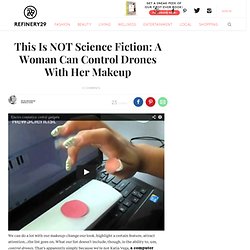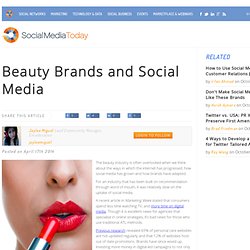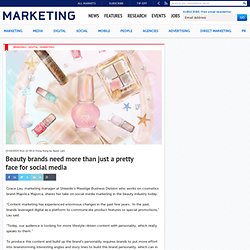

Sephora testa espelho que permitirá experimentar maquiagem virtualmente - O Negócio do Varejo. App contra acne. Agora você pode salvar seus posts favoritos.

Cadastre-se ou faça Login para começar! Já sou cadastrado Permanecer conectado. How technology is transforming cosmetics. Developed by L'Oréal in the US, Makeup Genius is a beauty app that uses facial mapping technology to transform your iPhone or iPad’s front-facing camera into a virtual mirror where you can 'try on' L'Oreal Paris products – including eyeliner and lipstick – in real time.

L'Oréal worked with a team of data scientists from Image Metrics – whose advanced facial mapping technology was used in the film The Curious Case of Benjamin Button – to incorporate a facial mapping algorithm into the app. Up until this point, the technology had only been used in Hollywood and in the gaming industry.
The algorithm captures 64 data points on your face, making it intuitive enough to discern between the skin of the lips, eyes and other facial contours. This means the virtual makeup moves with you as you turn your head, change your facial expression and test out new looks at various angles and lighting conditions. Beauty Technology — Makeup Drone Control. We can do a lot with our makeup: change our look, highlight a certain feature, attract attention...the list goes on.

What our list doesn't include, though, is the ability to, um, control drones. Mink Is A 3D Printer For Makeup. 3D printing is all the rage these days, but for now, it’s mostly centered around little plastic doo-dads.

The Mink, launching today on the Disrupt NY stage, is a bit different. The little printer lets users choose any color on the web, or in the real world, and using simple already-existing software, print that color into a blush, eye shadow, lip gloss or any other type of makeup. See, most makeup comes from the same basic substrates, from high-end labels like Chanel all the way down to the cheap stuff available at drug stores. Founder Grace Choi sources the same substrate for the Mink so that users can turn any image into any kind of makeup. The idea here is that consumers are increasingly focused on instant gratification and DIY solutions. Mink4 mink3 mink-grace mink2 mink1 mink Moreover, drug stores offer an incredibly limited selection of colors and options. Sephora’s Techy New Service Will Pinpoint Your Perfect Foundation. Beauty Brands and Social Media. The beauty industry is often overlooked when we think about the ways in which the internet has progressed, how social media has grown and how brands have adapted.

For an industry that has been built on recommendation through word of mouth, it was relatively slow on the uptake of social media. A recent article in Marketing Week stated that consumers spend less time watching TV, and more time on digital media. Though it is excellent news for agencies that specialise in online strategies, it’s bad news for those who use traditional ATL methods. Previous research revealed 69% of personal care websites are not updated regularly and that 12% of websites host out of date promotions. Brands have since wised up, investing more money in digital-led campaigns to not only improve their social media presence, but to achieve a higher ROI in areas that TV failed to deliver. Benefit Cosmetics (Above left: Magazine advertisement. Beauty brands need more than just a pretty face for social media.
Grace Lau, marketing manager at Shiseido’s Masstige Business Division who works on cosmetics brand Majolica Majorca, shares her take on social media marketing in the beauty industry today.

“Content marketing has experienced enormous changes in the past few years. In the past, brands leveraged digital as a platform to communicate product features or special promotions,” Lau said. “Today, our audience is looking for more lifestyle-driven content with personality, which really speaks to them.” To produce this content and build up the brand’s personality requires brands to put more effort into brainstorming interesting angles and story lines to build this brand personality, which can in turn connect with product features in soft-selling ways. Infographic: Social Media & The Beauty Industry. There are over 250,000 beauty salons in the United States, and chances are you probably visit one on a regular basis.

Or perhaps you have the pleasure of working for or owning one of these salons. Either way, there’s a strong likelihood social media has had some type of influence on what particular shop you frequent, or the type of clientele you typically bring it. This Infographic by Schoenheitsklinik.de highlights some important facts, trends and figures in reference to the influence of social media in the beauty, health and wellness industry. While this Infographic is full of great information, here are some particular highlights that will definitely help shape your current salons social media strategy. 1.
Ahh, the power of blogging. 2. Gone are the days when those interested in plastic surgery would call their doctors office, schedule an appointment, wait two weeks and then finally get the chance to ask their practitioners cosmetic surgery related questions. 3. How Founder of Beauty Brand Glossier Crafted the Launch on Instagram - WSJ.